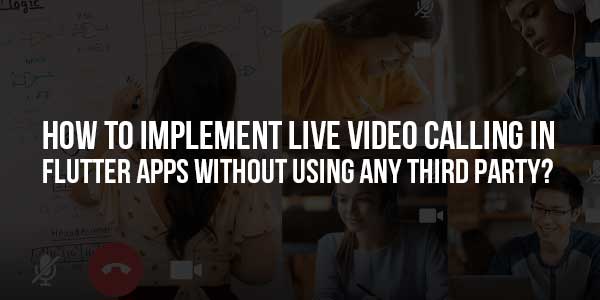
Table of Contents
How To Implement Live Video Calling In Flutter Apps Without Using Any Third Party
Live video calling has become an essential feature in modern mobile applications. While many developers rely on third-party SDKs like Agora, Twilio, or Zoom, building a custom solution gives you full control over performance, security, and cost. In this guide, we’ll explore how to implement live video calling in Flutter using WebRTC and Firebase—without any external dependencies.
Why Build A Custom Video Calling Solution?
Before diving into implementation, let’s understand why you might want to avoid third-party services:
- Cost Efficiency – No per-minute charges or subscription fees.
- Full Control – Customize UI/UX, security, and features.
- No Vendor Lock-In – Avoid dependency on external APIs.
- Better Privacy – Keep user data within your infrastructure.
“Building your own video calling solution may seem complex, but with WebRTC and Flutter, it’s entirely achievable without third-party services.”
Prerequisites For Flutter Video Calling
To follow this tutorial, ensure you have:
- Flutter SDK installed (version 3.0 or above)
- Basic knowledge of Dart and Flutter
- A Firebase project for signaling
- Physical devices or emulators with camera support
Understanding The Core Technologies
What Is WebRTC?
WebRTC (Web Real-Time Communication) is an open-source project that enables peer-to-peer audio, video, and data sharing directly between browsers and mobile apps. It handles:
- Media capture (camera & microphone)
- Encoding/decoding
- Network traversal (STUN/TURN)
- Secure transmission (DTLS-SRTP)
Role Of Firebase In Signaling
WebRTC needs a signaling mechanism to exchange session details before establishing a direct connection. Firebase Realtime Database acts as our signaling server to:
- Exchange SDP (Session Description Protocol) offers/answers
- Share ICE (Interactive Connectivity Establishment) candidates
- Manage call states (ringing, connected, ended)
Step 1: Setting Up The Flutter Project
Create a new Flutter project and add these dependencies in pubspec.yaml:
dependencies: flutter_webrtc: ^0.9.0 firebase_core: ^2.0.0 firebase_database: ^10.0.0 permission_handler: ^10.0.0
Configuring Firebase
- Create a Firebase project at Firebase Console
- Add Android/iOS apps and download configuration files
- Enable Realtime Database with test mode rules
Step 2: Implementing WebRTC In Flutter
Initializing WebRTC Components
Create a WebRTCService class to manage the video call lifecycle:
class WebRTCService { final RTCPeerConnection _peerConnection; final RTCVideoRenderer _localRenderer = RTCVideoRenderer(); final RTCVideoRenderer _remoteRenderer = RTCVideoRenderer(); Future initialize() async { await _localRenderer.initialize(); await _remoteRenderer.initialize(); } Future createPeerConnection() async { _peerConnection = await createPeerConnection({ 'iceServers': [ {'urls': 'stun:stun.l.google.com:19302'}, ] }); } }Handling Media Streams
Add methods to manage camera access and streams:
Future<MediaStream> getLocalStream() async { final Map<String, dynamic> constraints = { 'audio': true, 'video': { 'facingMode': 'user', 'width': {'ideal': 640}, 'height': {'ideal': 480} } }; MediaStream stream = await navigator.mediaDevices.getUserMedia(constraints); _localRenderer.srcObject = stream; return stream; }Step 3: Building The Signaling Mechanism
Firebase Database Structure
Design your Realtime Database schema for signaling:
{ "calls": { "callId123": { "caller": "userId1", "callee": "userId2", "offer": { ... }, "answer": { ... }, "iceCandidates": { "candidate1": { ... }, "candidate2": { ... } } } } }
Exchanging SDP Offers And Answers
Implement methods to handle signaling:
Future<void> createOffer(String callId) async { RTCSessionDescription offer = await _peerConnection.createOffer(); await _peerConnection.setLocalDescription(offer); FirebaseDatabase.instance.ref('calls/$callId').update({ 'offer': offer.toMap(), 'caller': currentUserId, }); } Future<void> handleAnswer(String callId) async { DatabaseReference ref = FirebaseDatabase.instance.ref('calls/$callId'); ref.child('answer').onValue.listen((event) { if (event.snapshot.value != null) { RTCSessionDescription answer = RTCSessionDescription.fromMap(event.snapshot.value); _peerConnection.setRemoteDescription(answer); } }); }Step 4: Establishing The Peer Connection
ICE Candidate Exchange
Handle ICE candidates for network traversal:
_peerConnection.onIceCandidate = (RTCIceCandidate candidate) { FirebaseDatabase.instance.ref('calls/$callId/iceCandidates') .push().set(candidate.toMap()); }; void listenForRemoteCandidates(String callId) { FirebaseDatabase.instance.ref('calls/$callId/iceCandidates') .onChildAdded.listen((event) { RTCIceCandidate candidate = RTCIceCandidate.fromMap(event.snapshot.value); _peerConnection.addIceCandidate(candidate); }); }Managing Call States
Implement call state management:
- Call Initiation – User creates offer
- Call Acceptance – Callee creates answer
- Call Rejection – Clean up resources
- Call Termination – Close peer connection
Step 5: Building The User Interface
Video Renderer Widgets
Create a widget to display video streams:
class VideoView extends StatelessWidget { final RTCVideoRenderer renderer; const VideoView({required this.renderer}); @override Widget build(BuildContext context) { return RTCVideoView(renderer); } }Call Controls
Add essential call controls:
Row( mainAxisAlignment: MainAxisAlignment.center, children: [ IconButton( icon: Icon(Icons.mic_off), onPressed: toggleMute, ), IconButton( icon: Icon(Icons.videocam_off), onPressed: toggleVideo, ), IconButton( icon: Icon(Icons.call_end), onPressed: endCall, color: Colors.red, ), ], )
Optimizing Performance And Reliability
Bandwidth Management
Adjust video quality based on network conditions:
void adaptVideoQuality(NetworkQuality quality) { final constraints = { 'video': { 'width': quality == NetworkQuality.Poor ? 320 : 640, 'height': quality == NetworkQuality.Poor ? 240 : 480, 'frameRate': quality == NetworkQuality.Poor ? 15 : 30 } }; _peerConnection.getSenders()[1].setParameters(constraints); }Error Handling And Reconnection
Implement robust error recovery:
- Monitor connection state changes
- Implement ICE restart on failure
- Add timeout for signaling exchanges
- Provide user feedback on connection issues
Conclusion
Building a live video calling feature in Flutter without third-party services gives you complete control over the user experience while reducing costs. By leveraging WebRTC for peer-to-peer communication and Firebase for signaling, you can create a fully functional video calling system. While this approach requires more initial setup compared to SDKs like Agora or Twilio, the long-term benefits in customization and cost savings make it worthwhile for many applications.
Remember to test extensively across different network conditions and devices. Consider adding features like call recording, screen sharing, or text chat to enhance your video calling solution further.

















Be the first to write a comment.